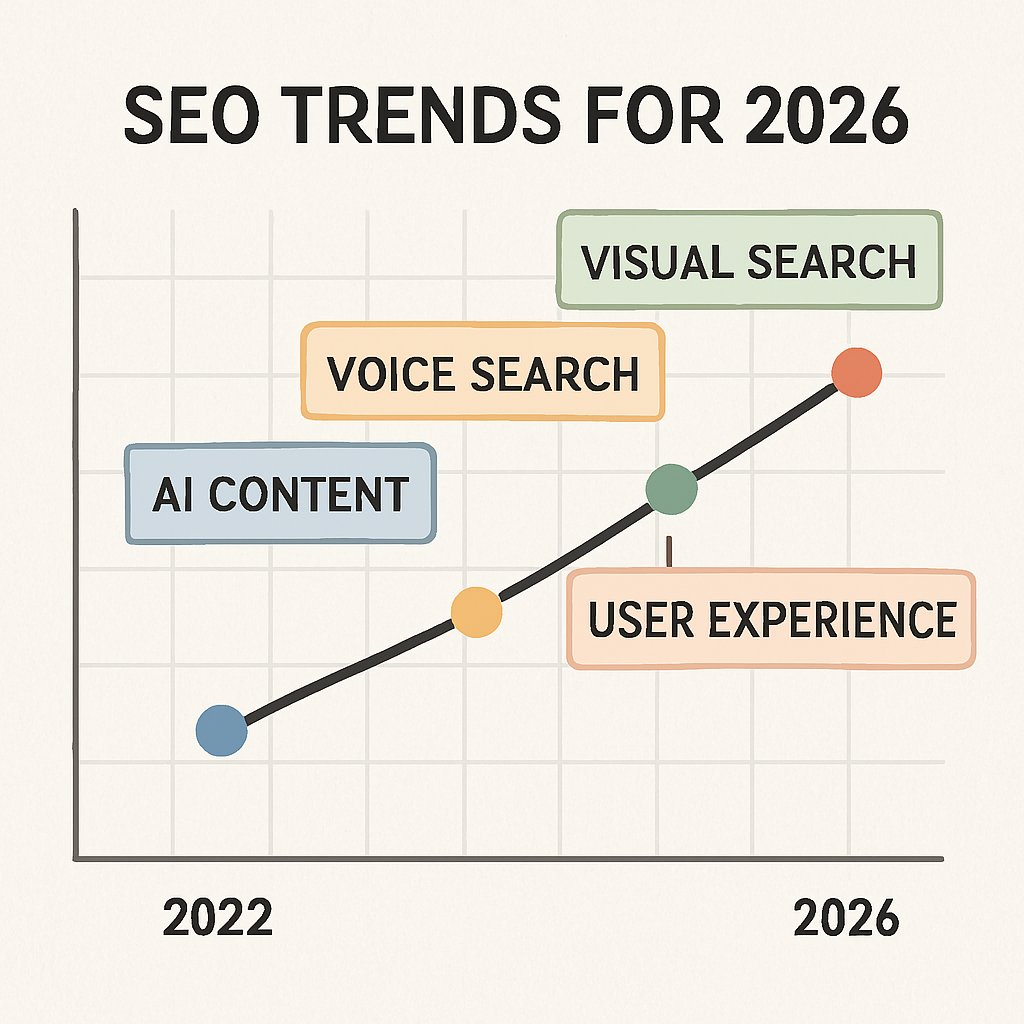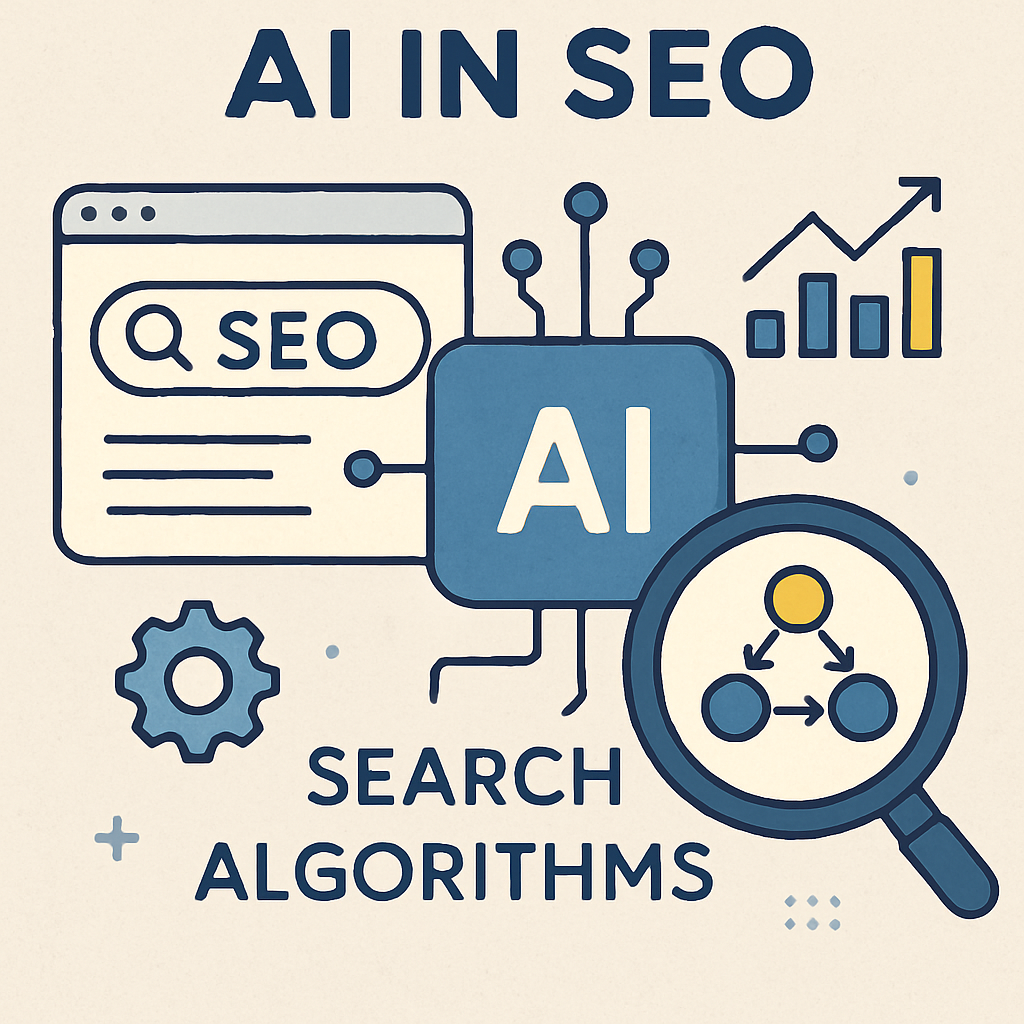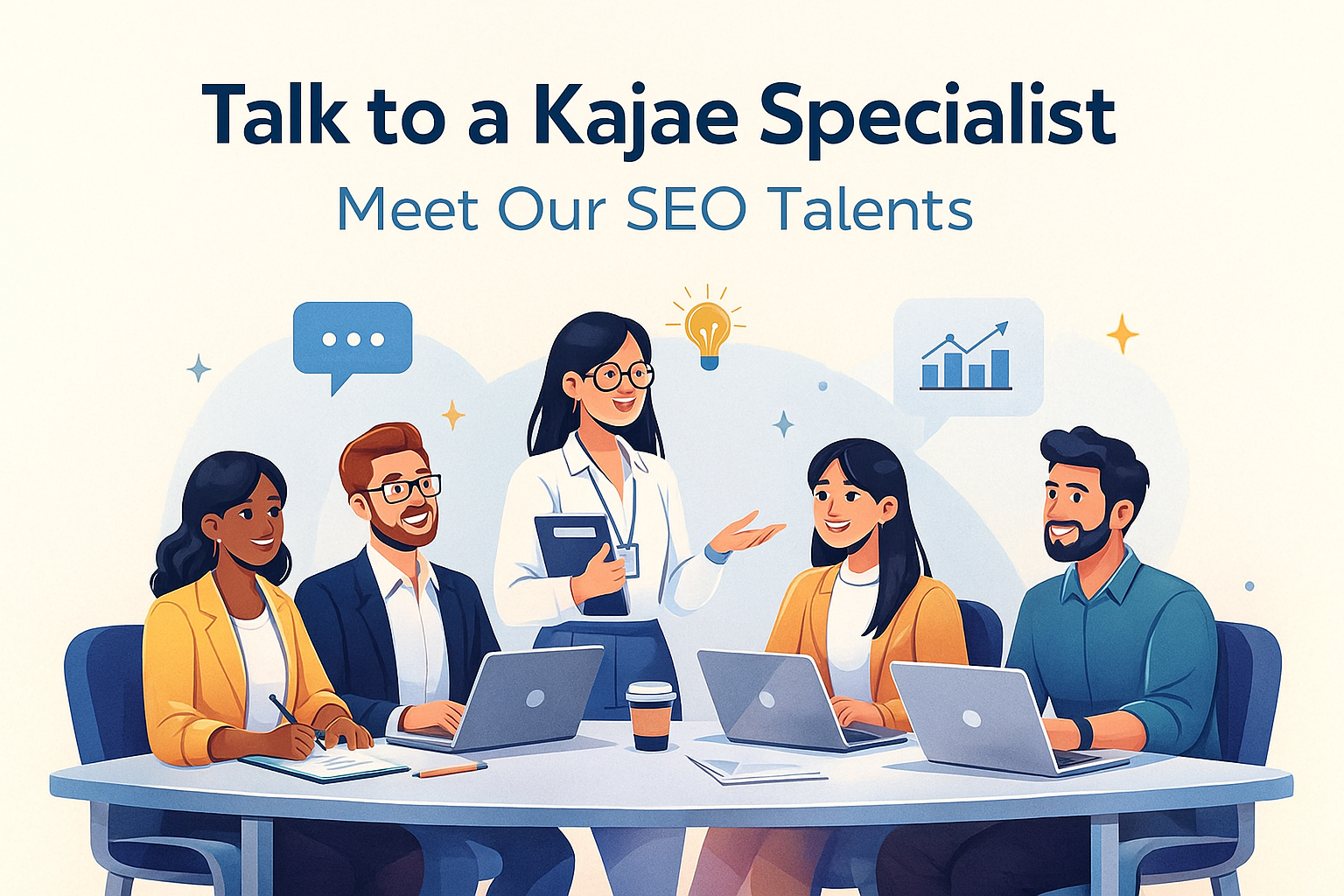The State of SEO in 2026: SEO Trends for 2026 and Key Industry Statistics
As we move into a new digital era, SEO for 2026 is becoming more sophisticated than ever. This year is marked by new ideas, data-based strategies, and changes driven by key SEO trends for 2026.
Voice search is growing. AI is now a big part of search algorithms. Mobile-first indexing is still a key ranking factor. With most searches now happening on mobile devices, mobile performance will significantly impact visibility.
User experience is taking center stage. Page speed, mobile responsiveness, and interactive elements are becoming essential ranking signals. At the same time, video and visual content are growing quickly. This supports a key SEO trend for 2026: search performance driven by multimedia.
Local SEO is becoming more popular. This is due to the rise in “near me” searches. Personalized intent is also more important for search engines.
The State of SEO Trends for in 2026: Key Statistics and Industry Overview
As we journey into 2026, SEO is becoming more sophisticated. It’s an era marked by rapid change and innovation. Voice search continues to grow, fueled by smart devices. This trend is significantly reshaping search behavior. AI and machine learning are at the forefront of search algorithms. They are enhancing personalization and search accuracy.
Mobile-first indexing remains crucial. With more searches happening on mobile devices, mobile search results decisively influence website rankings.
User experience is paramount. Page load speed and mobile responsiveness are key ranking factors. Video and visual content are becoming increasingly important. Their ability to engage users positively impacts search rankings.
Local SEO is gaining traction. More users are searching for businesses nearby, altering local ranking strategies.
Key Statistics for 2026:
- Voice Search: Over 55% of households will use voice-activated devices.
- AI Influence: Expected to contribute 30% of search query processing.
- Mobile Search: 70% of all internet searches will be conducted on mobile devices.
- Video Content: 85% more likely to rank on Google’s first page.
- Local Searches: 46% of all Google searches have local intent.
- User Experience: Sites that meet Core Web Vitals are 24% more likely to rank higher.

Increased focus on E-A-T (Expertise, Authoritativeness, Trustworthiness) is noticeable. Google’s reliance on these factors is growing.
Privacy regulations influence data-driven strategies. Companies are adapting to new norms for handling user data. SEO is no longer isolated. It intertwines with various digital marketing strategies. Collaboration is crucial for holistic growth.
As the landscape shifts, understanding these statistics is vital. They provide insights into shaping effective SEO strategies. Embracing these changes will be key to success in 2026. Marketers should prepare to navigate and leverage these trends.
AI and Machine Learning: The New Core of Search Algorithms
AI and machine learning are transforming SEO in unprecedented ways. They serve as pivotal components in search algorithms today.
Their presence is evident in personalized search experiences. By learning user behavior, AI tailors search results to each user.
Machine learning enhances the predictive capabilities of search engines. It analyzes data to forecast user queries accurately. These technologies refine search accuracy by interpreting complex language nuances. They improve semantic search understanding.
Google’s algorithms now process vast datasets with AI. They prioritize relevant, high-quality content over others. SEO experts should prioritize AI integration. By doing so, they ensure alignment with evolving algorithmic expectations.
AI and Machine Learning Impacts:
- Improved Relevance: Enhancing search result relevancy.
- Semantic Understanding: Better comprehension of user queries.
- Content Ranking: Prioritizing authoritative content.
- Personalization: Customizing search experiences.
- Efficiency: Streamlining data analysis processes.
- Adaptability: Rapid adaptation to algorithm changes.

With AI’s influence growing, SEOs must adapt their strategies. Embracing AI-driven analytics tools aids in this transition. Machine learning’s impact extends to voice search optimization. It fine-tunes voice recognition accuracy substantially. Keyword research automation is another AI contribution. Automated tools efficiently analyze keyword performance data.
Understanding these shifts is vital for SEOs. Anticipating changes allows for a strategic advantage in the competitive landscape. As AI continues to evolve, staying informed is crucial. It promises to reshape the future of search algorithms.
Voice, Visual, and Multimodal Search: Optimizing for the Next Generation
Voice search is becoming more popular in the digital world. Smart speakers are making it even more common. As a result, optimizing for voice search becomes essential, requiring an understanding of conversational language patterns. Visual search is also gaining popularity, as users increasingly seek information through images. Tools like Google Lens drive the growth of visual search by enabling users to gather data effortlessly via photos. Multimodal search combines these trends by integrating text, voice, and visual inputs to create richer user experiences.
SEOs must develop strategies that accommodate these new search methods to reach a broader audience. Key tactics include using structured data, optimizing for featured snippets, and creating images with descriptive alt texts. Primary strategies for voice, visual, and multimodal search include using natural language with conversational keywords. You can improve search visibility by using schema markup. Optimize images by adding descriptive alt texts—target snippets to get zero-click results. Use long-tail keywords to attract voice search traffic. Also, optimize videos for multimodal search.
Updating content with structured data is crucial for these trends, as it helps search engines better understand context. Additionally, visual content should use high-quality images with compression to maintain page speed. Incorporating long-tail keywords supports voice search optimization by mirroring casual user language. As search methods diversify, adaptability is key. Adjusting SEO strategies to include voice, visual, and multimodal searches will position websites at the forefront of digital innovation. Looking ahead, these trends are not slowing down. Embracing them now can help websites stay ahead in the changing digital world.
Mobile-First and User Experience: Ranking Factors You Can’t Ignore
Mobile-first indexing is no longer just a trend; it’s a reality. Google prioritizes mobile content in its ranking algorithm, so a responsive design is crucial. Without a mobile-friendly site, your SEO efforts may falter.
User Experience (UX) plays a significant role in SEO success. Fast loading times and easy navigation greatly enhance UX. These factors directly influence a site’s bounce rate and dwell time.
Page speed is a critical aspect of mobile SEO. Users expect sites to load quickly, or they may bounce back to search results. Thus, optimizing images and using accelerated mobile pages (AMP) can help.
Responsive design ensures content is accessible across all devices. This approach creates a seamless experience for users, regardless of screen size. Well-structured, legible text is also essential.
Accessibility goes hand-in-hand with UX. Make sure that pages cater to all users, including those with disabilities. This involves implementing proper alt text for images and ensuring keyboard navigation.
These elements influence user engagement on mobile devices. Improving user experience helps with Google’s mobile-first indexing. It also makes users happier, which can raise your rankings.
Key Components of Mobile-First and UX Optimization:
- Responsive Design: Adapt content to various device sizes.
- Fast Loading: Optimize speed to lower bounce rates.
- Easy Navigation: Improve user pathways.
- Accessibility: Ensure usability for all audiences.
- Optimized Images: Reduce file sizes without losing quality.
- Mobile Testing: Regularly assess performance on mobile devices.
Optimizing for mobile experience requires ongoing effort. Regular checks with tools like Google’s Mobile-Friendly Test ensure peak performance.
A focus on UX reflects positively on SEO. Thoughtful design and swift navigation invite users to stay longer.
In the fast-evolving digital landscape, mobile-first strategies set you ahead. Combining UX with mobile optimization will help maintain your site’s competitive edge in 2026 and beyond.

Content Quality, E-E-A-T, and Authority: Winning Google’s Trust
In 2026, quality content will still reign supreme in SEO. Google’s focus on quality content ensures users receive the best information. High-quality content engages audiences and enhances their experience.
E-E-A-T, which stands for Experience, Expertise, Authoritativeness, and Trustworthiness, is pivotal in Google’s ranking criteria. Content creators must demonstrate deep understanding and competence in their subject matter. This builds user trust and positively impacts rankings.
Authority comes from reputation and quality backlinks. Creating well-researched content that others reference is one way to build authority. Collaborate with industry experts to bolster credibility.
Trustworthiness stems from transparent, factual content. Proper citations and quality sources enhance reliability. Avoid misleading information; integrity is vital to maintaining user trust.
Consider structuring content to improve readability. Break it into digestible pieces, using headings, bullet points, and visuals. This organization aids user understanding and keeps them engaged.
Interactive elements, such as quizzes or polls, can further boost engagement. These tools provide a dynamic user experience, increasing time spent on your site. More engagement often results in higher rankings.
Tips for Winning Google’s Trust with Quality Content:
- Demonstrate Expertise: Show deep understanding and knowledge.
- Build Authority: Gain backlinks and reputable partnerships.
- Ensure Trustworthiness: Use accurate, well-cited information.
- Optimize Readability: Use headings and clear structures.
- Engage Users: Incorporate interactive content.
- Update Regularly: Keep content fresh and relevant.
Refreshing content is crucial for maintaining relevance. Regular updates ensure that information remains current.
In the coming years, Google will continue valuing E-E-A-T. By focusing on these elements, sites can cultivate trust and improve rankings.
Ultimately, quality content anchored by E-E-A-T principles will form the backbone of successful SEO strategies in 2026.
Video, Audio, and Interactive Content: The Rise of Engaging Formats
As we look ahead to 2026, the importance of multimedia content in SEO cannot be overstated. Visual and auditory content captivate audiences in ways text alone cannot. Users engage more when content is dynamic and immersive.
Videos are highly effective in conveying messages succinctly. They attract more clicks and shares compared to static content. Platforms such as YouTube are essential for digital marketing strategies. Embedding videos directly on websites can also enhance user experience and retention.
Podcasts and audio files cater to audiences who consume content on the go. Audio allows access to information without visual demands. This format is gaining traction and is vital for engaging an increasingly mobile audience.
Interactive content, such as quizzes and infographics, elevates user interaction. By involving the audience, these formats boost engagement time and retention rates. This interaction also fosters a deeper connection with the content and the brand.
Benefits of Engaging Formats:
- Boosts Engagement: Holds audience attention longer.
- Enhances Accessibility: Reaches people in various contexts.
- Increases Shareability: Encourages social media distribution.
- Improves SEO Metrics: Positively affects site metrics such as dwell time.

Incorporating diverse content formats isn’t just a trend; it’s a necessity. They cater to different user preferences, enhancing reach and impact.
Looking forward, brands leveraging video, audio, and interactive elements will likely see improved SEO outcomes. They will engage more users and drive better traffic in 2026.
Local SEO, Reviews, and Personalization: Capturing Intent in 2026
In 2026, local SEO is expected to become even more pivotal for businesses. Consumers frequently search for nearby services and products. Capturing local search intent will be crucial for reaching potential customers effectively.
Reviews will play a vital role in shaping consumer decisions. Positive feedback can significantly influence local search rankings. Businesses need to engage with customers to build a strong online reputation actively. Managing reviews is an essential aspect of maintaining credibility and trust.
Personalization is transforming how users interact with digital content. Personalizing search results ensures users find exactly what they’re looking for. Tailored experiences better meet user expectations, leading to higher satisfaction and conversion rates.
Key Factors to Enhance Local SEO and Personalization:
- Accurate Business Listings: Ensure up-to-date information on local directories.
- Active Review Management: Engage with customer reviews to maintain a positive image.
- Customized Content: Craft messages that resonate with local audiences.
- Localized Keywords: Use terms specific to your region to enhance relevance.
For businesses aiming for success in 2026, focusing on local SEO and personalization is non-negotiable. These strategies not only improve search visibility but also drive customer engagement and loyalty. Enhancing local intent capture will support stronger, more personal connections with audiences.
Structured Data, Schema, and Zero-Click Results: Maximizing Visibility
The search landscape is evolving, with zero-click results becoming increasingly prevalent. These appear directly in SERPs, answering queries without users having to click through. Optimizing for zero-click can be a powerful way to improve visibility.
Structured data and schema markup play a crucial role in this trend. They help search engines better understand content, thereby enhancing its display. Implementing these can lead to rich snippets, which improve user engagement.
Using schema markup can boost your chances of appearing in enhanced search results. Such visibility is vital for capturing user attention. It reduces the friction in finding answers and drives brand recognition.
Strategies for Optimizing with Structured Data:
- Implement Schema Markup: Use relevant schemas to describe your content.
- Focus on FAQs: Provide concise answers to common questions.
- Utilize Rich Snippets: Enhance the visual appeal of search results with additional information.
By prioritizing structured data and schema markup, you can dramatically enhance search visibility. These strategies not only meet search algorithms’ needs but also improve user experience. Adapting to this trend ensures that content reaches more users efficiently.
Backlinks, Brand Signals, and Online Reputation: Building Trust in a Crowded Market
In a competitive digital landscape, trust is a key differentiator. Building trust starts with high-quality backlinks. These are links from reputable sites pointing to your content, which search engines see as votes of confidence.
It’s not just the quantity, but the quality of backlinks that matters. Search engines prioritize links from authoritative sources. Focus on building relationships with respected sites in your niche.
Brand signals further enhance trustworthiness. Consistent brand messaging and engagement can boost your search rankings. An active social media presence often correlates with better online visibility.
Managing online reputation is crucial. Regularly monitor reviews and feedback about your brand. Promptly addressing negative reviews can prevent lasting damage.
Key Actions to Build Trust:
- Pursue Quality Backlinks: Collaborate with authoritative sites.
- Strengthen Brand Signals: Be active and consistent across platforms.
- Manage Online Reputation: Address reviews and feedback efficiently.

Improving these aspects can significantly enhance your SEO outcomes. Focus on these strategies to build your site’s authority. This will help create trust with users and search engines. Building a strong reputation forms the foundation for sustainable SEO success.
AI Tools, Automation, and Data Analytics: The Future of SEO Workflows
AI-driven tools are revolutionizing SEO workflows. They streamline processes like keyword research, content creation, and competitor analysis. These tools can identify trends faster than manual methods.
Automation is reducing repetitive tasks. SEO professionals can now focus more on strategy rather than manual data gathering. This shift enables efficient resource allocation and quick strategy adjustments.
Data analytics is at the heart of successful SEO. It provides insights into user behaviors and preferences. Analyzing data helps tailor content and strategies to user needs, boosting engagement.
Integrating AI, automation, and analytics leads to a more agile SEO strategy. Companies can respond to search algorithm updates and market changes swiftly. Staying up to date with these advancements is essential.
Key Benefits of AI and Automation in SEO:
- Enhanced Efficiency: Automate repetitive tasks to save time.
- Data-Driven Insights: Use analytics for strategic content adjustments.
- Agility in Strategy: Quickly adapt to SEO changes and trends.
by Growtika (https://unsplash.com/@growtika)
Adopting these technologies keeps businesses ahead. They empower SEO strategies with precision and speed. This integration is the future of effective search engine optimization.
Privacy, Security, and Regulatory Trends: Navigating the New Digital Landscape
Digital privacy is becoming a significant concern. Users demand more control over their personal data. This shift influences SEO strategies, emphasizing data protection.
Regulatory changes, such as GDPR, enforce strict data-handling rules. Businesses must comply with these legal requirements to avoid penalties. Compliance with such regulations builds trust with users and search engines.
Security is also integral to SEO. Websites with HTTPS enjoy better rankings. Encryption assures users that their data is safe, thereby enhancing user engagement on the site.
Key Considerations for SEO in Privacy and Security:
- Compliance with Data Laws: Understand and implement GDPR and similar regulations.
- Focus on Data Security: Ensure the website uses HTTPS.
- User Privacy Priority: Incorporate privacy-centric features to build trust.
Navigating this landscape requires vigilance. Staying informed on regulatory updates is crucial for an effective SEO strategy. This ensures both compliance and a positive user experience.
Integrating SEO with Digital Marketing Trends: A Holistic Approach
SEO should not stand alone. Today, it is part of a broader digital marketing strategy. This integration maximizes content reach and engagement.
By connecting SEO with other digital marketing trends, businesses can improve their online presence. This includes using social media and email marketing. Cross-channel marketing bolsters SEO efforts by directing a diverse audience to your site.
Data analytics plays a crucial role in this approach. Marketers can use insights to refine strategies across different platforms. Data ensures each channel supports broader SEO goals, enhancing effectiveness.
Ways to Integrate SEO with Other Digital Marketing Strategies:
- Sync SEO with Social Media: Drive traffic through coordinated campaigns.
- Utilize Email Marketing: Boost site visits and engagement.
- Leverage Data Analytics: Inform cross-channel strategies.

A holistic approach means every part supports the whole. When SEO complements digital marketing strategies, the cumulative effects boost both reach and authority. Such synergy is key to future success.
Actionable SEO Best Practices for 2026: Your Ranking Strategy Checklist
Staying ahead in SEO demands following best practices. As SEO trends evolve, so should your strategies. Focusing on flexibility and learning ensures steady progress.
Prioritize user experience (UX) on your site. Fast load times and smooth navigation are crucial. Google values sites that provide superior user experiences and rewards them with higher rankings.
In 2026, content remains king. However, quality must meet the E-E-A-T criteria: Expertise, Experience, Authoritativeness, and Trustworthiness. Always aim for content that is relevant, well-researched, and engaging.
Checklist for 2026 SEO Best Practices:
- Optimize for Voice Search: Future-proof with natural language queries.
- Enhance Mobile Experience: Cater to mobile-first indexing.
- Implement Structured Data: Improve visibility and clarity.
- Leverage Video Content: Engage users and boost rankings.
- Focus on Local SEO: Capture intent with regional strategies.
By updating practices to align with these strategies, you prepare for future challenges and opportunities. Continuous learning and adaptation remain your best tools in navigating SEO’s evolving landscape.
Conclusion: Preparing for the Future of SEO
The SEO landscape for 2026 is packed with opportunities and challenges. Embracing innovation is crucial for maintaining a competitive edge. Keeping abreast of trends and emerging technologies offers significant advantages.
Strategic adaptability is key to thriving amid changes. By refining your strategies and remaining flexible, you can navigate the dynamic world of SEO. Leveraging data-driven insights will inform smarter decisions that align with user expectations.
Ultimately, continuous learning and strategic adjustments will prepare you for success. Embrace new tools and methodologies as they arise. With a proactive approach, the future of SEO can be exciting and rewarding, leading to sustainable growth.

-
SEO Trends for 2026: Must-Know Insights to Strengthen Your Strategy
Top executives know that offshore talent is more than a cost-saving strategy—it’s a source of innovation, agility, and global expertise. Discover what leaders value most in skilled offshore staff, from cultural intelligence to the soft skills of offshore developers, and learn how Kajae connects companies to world-class talent sources offshore.
-
Essential Skills Every Project Manager Needs
Top executives know that offshore talent is more than a cost-saving strategy—it’s a source of innovation, agility, and global expertise. Discover what leaders value most in skilled offshore staff, from cultural intelligence to the soft skills of offshore developers, and learn how Kajae connects companies to world-class talent sources offshore.
-
GenAI Transformation: The Future of AI Unlocked
Top executives know that offshore talent is more than a cost-saving strategy—it’s a source of innovation, agility, and global expertise. Discover what leaders value most in skilled offshore staff, from cultural intelligence to the soft skills of offshore developers, and learn how Kajae connects companies to world-class talent sources offshore.
-
Achieve More: Hire an Executive Assistant Now
Top executives know that offshore talent is more than a cost-saving strategy—it’s a source of innovation, agility, and global expertise. Discover what leaders value most in skilled offshore staff, from cultural intelligence to the soft skills of offshore developers, and learn how Kajae connects companies to world-class talent sources offshore.
-
Unlock the Power of Staff Augmentation Over Outsourcing
Top executives know that offshore talent is more than a cost-saving strategy—it’s a source of innovation, agility, and global expertise. Discover what leaders value most in skilled offshore staff, from cultural intelligence to the soft skills of offshore developers, and learn how Kajae connects companies to world-class talent sources offshore.
-
Hire a Trusted Offshore Graphic Designer for Bold Results
Top executives know that offshore talent is more than a cost-saving strategy—it’s a source of innovation, agility, and global expertise. Discover what leaders value most in skilled offshore staff, from cultural intelligence to the soft skills of offshore developers, and learn how Kajae connects companies to world-class talent sources offshore.


Leave a Reply